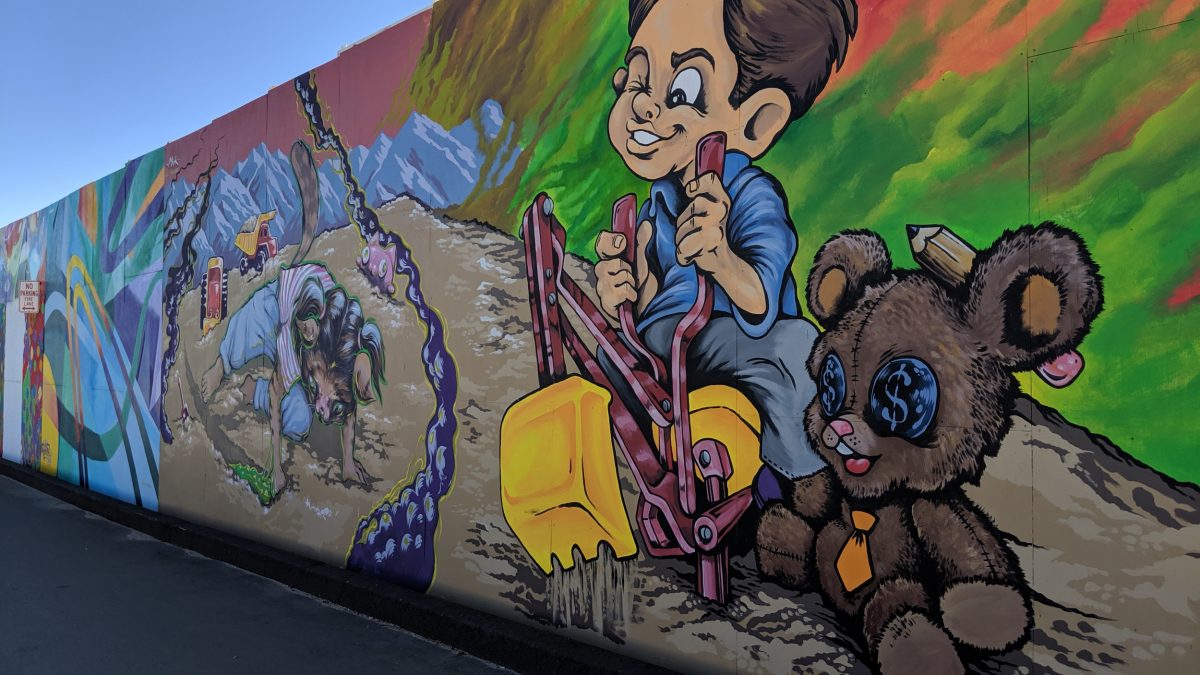This story is a reprint from the Winter 2019/Spring 2020 College of Liberal Arts Magazine.
Bluebird skies frame the mural-adorned plywood wall that defines the southern border of Swansea Elementary School in Denver. The 700-foot-long wall shields parents, children, and educators from the material effects of sinking a two-mile portion of I-70 below grade. The work is part of a 10-mile, four-year expansion project to upgrade the congested and aging infrastructure. In 2018, Colorado Department of Transportation selected 30 Denver-area artists to help transform the wall that separates the school from the I-70 construction zone into a “fun and safe space.”
The wall, and the construction on the other side, occupy the place where Swansea Elementary recess once took place. The murals depict wonder and intrigue with their colorful, larger-than-life-size paintings of basketball, social justice, and cartoon heroes at play. Most evoke cheerful innocence. One offers a sinister criticism of the wall’s existence.

Xochitl Ramirez, a senior double-majoring in social work and communication studies, walks the length of the wall with Dr. Greg Dickinson. Her classmates from “Communicating Urban Identities” walk and talk in groups, saunter alone snapping photos, and peer heads around the wall’s west end to view the expansive I-70 construction.
The small class – six communication studies majors and four economics majors – traveled to northeast Denver on a Saturday in late September to visit different redevelopment sites in the neighborhoods surrounding the existing National Western Complex located at I-70 and Brighton Boulevard. The 250-acre complex is being transformed into the National Western Center, which will include a new urban campus for the Colorado State University System.

By early afternoon students had already visited the future site of the NWC, speaking at length with Jocelyn Hittle, Senior Director for Colorado State University System’s Denver Programs and Sustainability, and walked the stacks inside the Elyria-Swansea Public Library one mile east. They hoped to tour The GrowHaus, a nonprofit indoor farm in Elyria-Swansea that seeks to create a healthy, equitable, and resident-driven neighborhood food system, but the center was unexpectedly closed for seasonal maintenance.
Earlier at lunch in the RiNo (River North) district located southwest of the Elyria-Swansea neighborhood, Ramirez shared with her fellow students that her close childhood friend, Karina, had grown up in Elyria-Swansea just one block from the stock show grounds.
“Her family had to move last year,” Ramirez said. Eminent domain had taken the family’s house for improvements to Brighton Boulevard, which borders Elyria-Swansea to the east and the NWC to the west.
Ramirez, who grew up to the east of Elyria-Swansea in the Montebello neighborhood, met Lydia through church. Their families were close friends. Ramirez spent a lot of her childhood at Lydia’s house.
As Ramirez walks the length of the wall with Dickinson she goes back in time to her childhood, but with difficulty. “I’m trying to remember what used to be here,” Ramirez tells Dickinson. “All I see is what’s here now.”
Ramirez stares into the construction site. The earth has been excavated well below grade. Pile drivers are frozen in time, waiting for Monday to resume the work of setting new foundation. Plans for the I-70 expansion include capping a section of the interstate to create a new urban greenspace.
“It’s like they dug up your memories,” Dickinson responds.
Ramirez nods and lifts her phone to photograph the construction site looking to the east and then the west. For now, the scene shows two vastly different realities separated by 6-inches of plywood. What you see depends on where you stand.